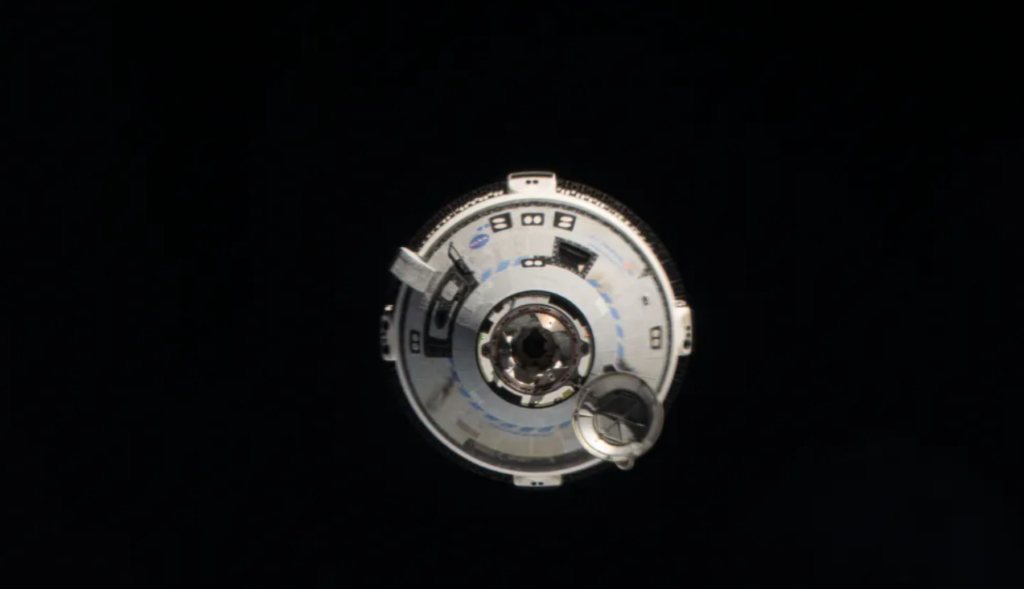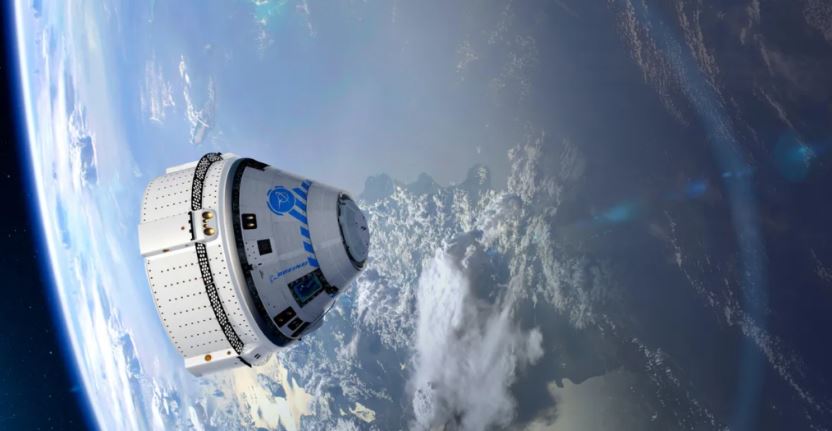It’s now been about 6 days since Starliner docked to the International Space Station for the first time with Crew, and already teams are starting to prepare for undocking and reentry. This includes ground teams assessing the five helium leaks on Starliner to determine if they pose any risk for the return mission.
A recent statement suggests that they don’t plan to leave the station until June 18th at the earliest. That gives the crew time to complete more Starliner-related tests at the station and ground crews to check and make sure the spacecraft is operating as intended. Here I will go more in-depth into the current state of Starliner, the impact of its leaks, the crew’s progress, and more.
Helium Leak Status

In a new statement released by the agency, they provided some updates regarding what the crew has been up to along with any problems Starliner experienced or is still experiencing. For example, in one quote the agency says, “One of Starliner’s aft-facing reaction control system (RCS) thrusters, capable of about 85 pounds of thrust, remains de-selected as teams continue to evaluate its performance. Ground teams plan to fire all 28 RCS thrusters after undocking to collect additional data signatures on the service module thrusters before the hardware is expended. As part of normal operations, the service module separates from the crew module on return, so NASA and Boeing will gather as much data as possible to aid in system assessments” they said.
This has to do with some of the RCS issues that occurred during the initial docking attempt. In that instance, they were able to get all the thrusters working again with the exception of one. Relative to undocking and reentry, the remaining 27 thrusters are more than enough to safely control and operate the vehicle. It’s also important to point out that the main reentry process involves the capsule itself as the service module is discarded soon before Earth reentry. In other words, as long as the service module can safely undock and help position and orient the spacecraft the right way, its job is done.
This is where the helium leaks come in. In another quote, the agency points out, “Teams currently are assessing what impacts, if any, five small leaks in the service module helium manifolds would have on the remainder of the mission. Engineers evaluated the helium supply based on current leak rates and determined that Starliner has plenty of margin to support the return trip from the station.” They went on to say, “Only seven hours of free-flight time is needed to perform a normal end of mission, and Starliner currently has enough helium left in its tanks to support 70 hours of free flight activity following undocking. While Starliner is docked, all the manifolds are closed per normal mission operations preventing helium loss from the tanks” they said.
For context, Starliner initially had one leak before launch but it was small enough that NASA and Boeing were fine launching the spacecraft as is. Once in orbit, a few more popped up before the eventual docking to the ISS. At that point, they closed the manifolds stopping any escape of helium as the spacecraft was now docked and didn’t need the related systems. When it goes to undock they will then open up these manifolds and the leaks will begin. That being said, this statement suggests that they have much more helium than is necessary so the leaks shouldn’t be a problem. Between now and June 18th, we can expect a few more updates on the plan and specifically the helium to ensure that the margin stays the same or within an acceptable range for reentry.
Besides work on the helium leaks and RCS thrusters, a new issue was found with a valve. Here, NASA was quoted saying, “Engineers also are evaluating an RCS oxidizer isolation valve in the service module that is not properly closed. Ground teams performed a successful propulsion system valve checkout on Sunday. All other oxidizer and fuel valves within the service module were cycled normally. The suspect oxidizer isolation valve was not cycled in the recent checkout. It will remain commanded closed for the remainder of the mission while ground teams continue to evaluate its data signatures.” They then clarified, “The crew module propulsion valves, which are part of an independent system that steers the capsule in the last phase of flight before landing, also were successfully cycled, and all those valves are performing as designed” they said.
Thankfully, it seems that any issues Starliner is currently having primarily have to do with the service module and not the capsule itself. This supports most of the reentry process but will definitely be monitored as the undocking date approaches. In the meantime, the Starliner crew has been very busy at the station.
Starliner’s Return

Even though this mission launched two humans, it’s still a test. With this comes much more work than just transporting a crew to and from the ISS safely. In order to certify Starliner for future much more frequent crewed missions into orbit, they are doing a final round of tests in space. Here, Wilmore and Williams, along with teams on the ground, are stepping through numerous flight objectives such as powering the spacecraft down into a minimal power mode, which it will enter during operational missions while the crew works aboard the station, and then powering it up again. They also are conducting “safe haven” checks to show the spacecraft can support a crew with its own air and consumables during in an emergency on the station. Another test is performing a habitability study with two other astronauts, to evaluate seating positions and other factors, such as air circulation for a four-person crew. Finally, they are also evaluating spacesuits and seat-fits, as well as checkouts of the service module’s batteries.
In terms of the state of the crew, Steve Stich, manager of NASA’s Commercial Crew Program said, “Butch and Suni are doing great aboard station as ground teams continue digging into the details of Starliner’s on-orbit, rendezvous, and docked performance. We expected to do a lot of valuable learning on this test flight, and I am extremely proud of how the NASA and Boeing teams are working together to ensure we can safely execute the return portion of the mission” he said.
In a statement, NASA was quoted saying, “Mission managers are continuing to work through the return plan, which includes assessments of flight rationale, fault tolerance, and potential operational mitigations for the remainder of the flight.” They also mentioned that the agency and Boeing will host a media briefing before the undocking which will provide more information.
At this point, with launch and docking already completed, the last remaining dynamic phase of the mission will come at the end of the flight test when Starliner will undock from the orbiting laboratory and then adjust its orbit to move away from the space station. The spacecraft, with Wilmore and Williams aboard, will perform a deorbit burn before entering the atmosphere and landing in the southwestern United States under parachutes and landing airbags to complete the flight. Besides the date of June 18th which is the earliest opportunity, it’s still somewhat up in the air when they will decide to undock. As they get closer they will make sure everything is in order and determine the safest and most favorable time to leave the station and return to Earth.
When that day is decided, Starliner will be packed, powered up, and prepared for departure. Then, the docking mechanism disengages, letting Starliner slowly drift away from the space station. After a flyaround inspection, Starliner conducts a series of burns to take it safely away and position it for deorbit. One of the next flight test objectives will assess the manual piloting of Starliner before switching back to autonomous operations. The crew will spend approximately six hours in the spacecraft from undocking until its first landing opportunity.
With this being Starilner’s third trip to space, it’s already had a few reentry attempts before. Both previous attempts had a few software or thruster complications around the time of reentry but made it through safely for an eventual landing. During re-entry to Earth’s atmosphere, the spacecraft will begin to slow down from orbital velocity at 17,500 mph (28000km/h). Once it makes it through the main reentry process and is within Earth’s atmosphere, the spacecraft’s forward heat shield will be jettisoned. Soon after, two drogue and three main parachutes will further slow Starliner’s descent. One of the things that delayed this launch was working on a parachute safety margin issue. That since has been addressed and should not pose any risk to the crew or capsule.
As it gets closer to the ground, the base heat shield will deploy, exposing the dual airbag system. The six primary airbags will deploy at the base of the capsule, cushioning its landing at approximately 4 mph in the western United States. There are a few landing sites available that they will end up choosing as the date gets closer. Assuming a successful touchdown, Starliner should get certified and become another official commercial crew vehicle. Boeing Starliner-1, also called Post Certification Mission-1, is planned to be the first operational crewed mission of the Boeing Starliner to the International Space Station as part of the Commercial Crew Program. This is scheduled to happen not long from now in 2025. We then could begin seeing the spacecraft launch much more frequently and with even bigger crews.
Conclusion
Boeing’s Starliner spacecraft is docked to the ISS and getting ready for an eventual undocking and reentry. There are still the existing helium leaks among other issues that NASA and Boeing are watching however they are confident they don’t pose any risk to the crew or vehicle. We will have to wait and see how it progresses and the impact it has on the space industry.

I just hope the crew return safely.
Hey people!!!!!
Good mood and good luck to everyone!!!!!